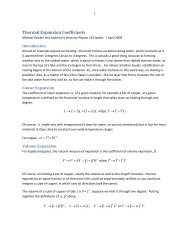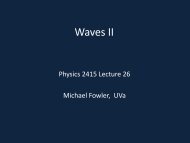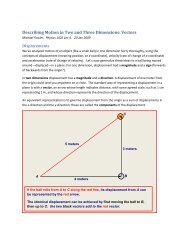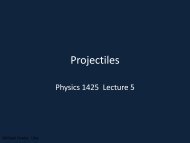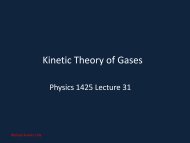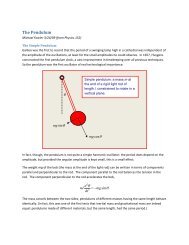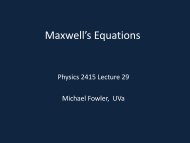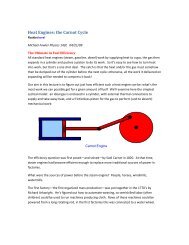Class Notes on Rotational Motion - Galileo and Einstein
Class Notes on Rotational Motion - Galileo and Einstein
Class Notes on Rotational Motion - Galileo and Einstein
Create successful ePaper yourself
Turn your PDF publications into a flip-book with our unique Google optimized e-Paper software.
8Moments of Inertia for Extended BodiesWe’ve <strong>on</strong>ly found the “moment of inertia” for a single mass attached to a light disk. What aboutsomething more complicated, for example a heavy disk?The key to finding the moment of inertia for a solid body is to visualize it as a lot of small masses allglued together. Think specifically of a heavy wheel of radius R, rotating about a fixed axle with negligiblefricti<strong>on</strong>. Imagine the wheel to be initially at rest, then a force F is applied to the rim tangentially, so thatthe torque is FR. Of course, the whole wheel begins to rotate, so think what happens to <strong>on</strong>e of the smallmasses m i we are imagining the wheel to be made up of. If it is at a distance r i from the axle, <strong>and</strong> theinitial angular accelerati<strong>on</strong> of the wheel is , this small mass, m i say, must experience an initialaccelerati<strong>on</strong> r i , so there must be a total force <strong>on</strong> it of f i = m i r i , <strong>and</strong> therefore a torque acting <strong>on</strong> it off i r i = m i r i 2 .Rigid wheel made up ofmany little masses m i :when external torqueFR is applied, m i hasinitial linearaccelerati<strong>on</strong> r i α, soexperiences torque:axler im iFτ i = f i r i = m i r i 2 But where, exactly does this torque come from? Ultimately, it must come from the force F beingapplied to a different part of the wheel, but the immediate cause for the small mass m i ’s accelerati<strong>on</strong> isjust the pulls <strong>and</strong> pushes of its neighbors.In other words, if you push <strong>on</strong> <strong>on</strong>e part of the wheel, since it’s a solid body its rigidity transmits theeffect of the force to all the other parts, so the wheel rotates as a whole—provided of course the forceis not str<strong>on</strong>g enough to tear the wheel apart.Since the torque felt by <strong>on</strong>e small part of the wheel τ i = m i r i 2 , the total torque felt by all the parts ofthe wheel is:τ = Στ i = m i r i 2 = dmr 2 with the integral being over all the tiny masses dm making up the wheel.




